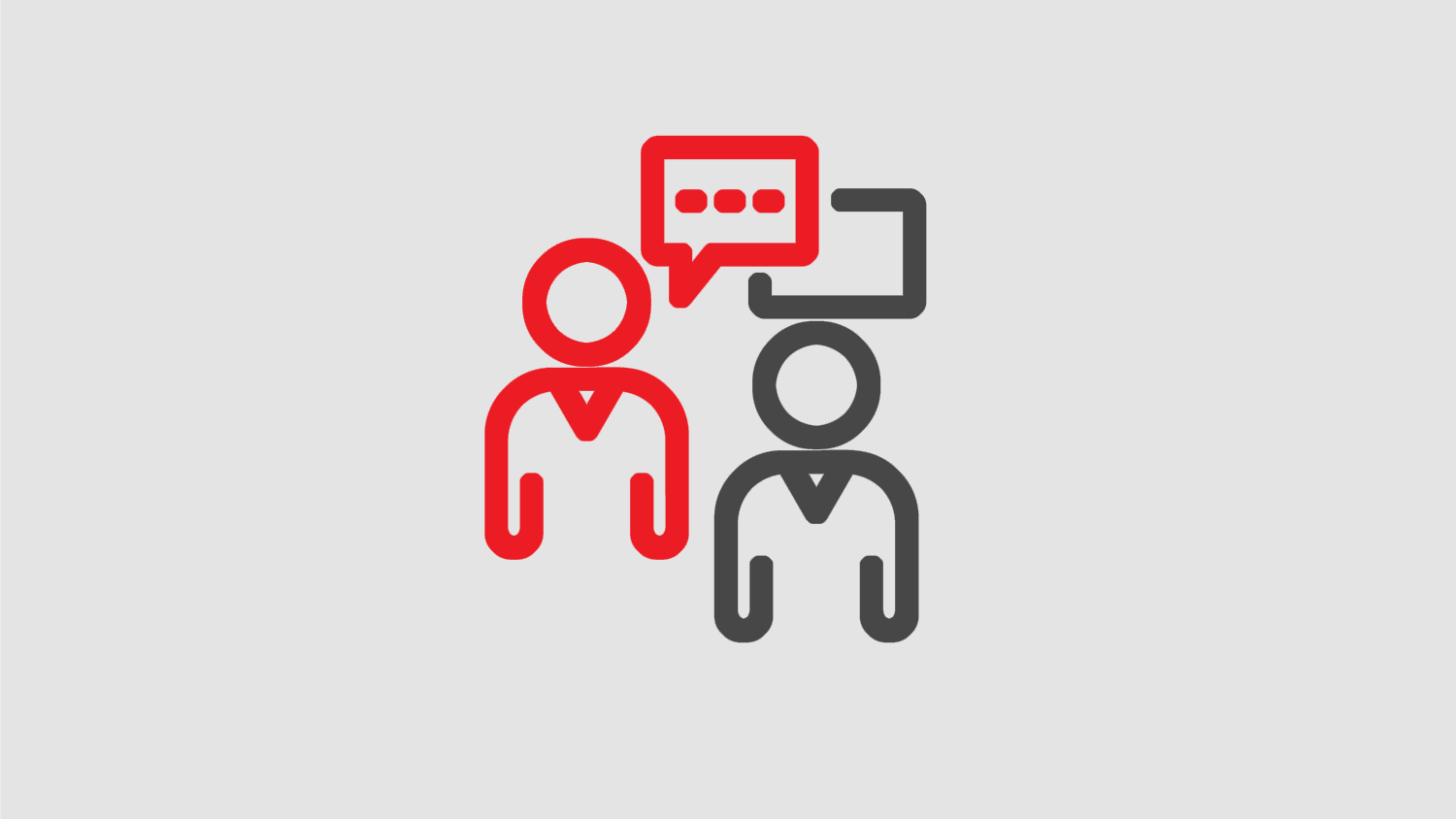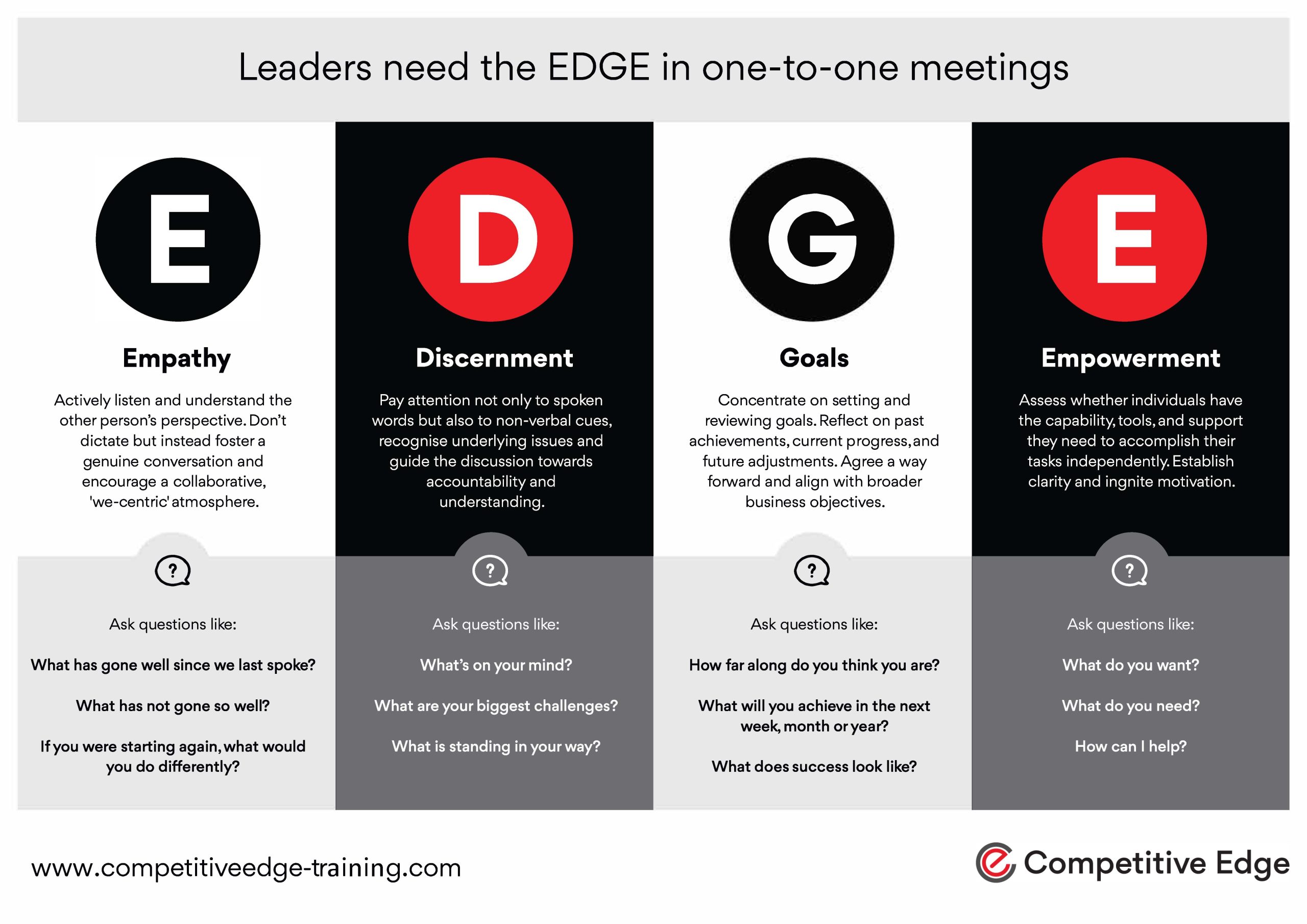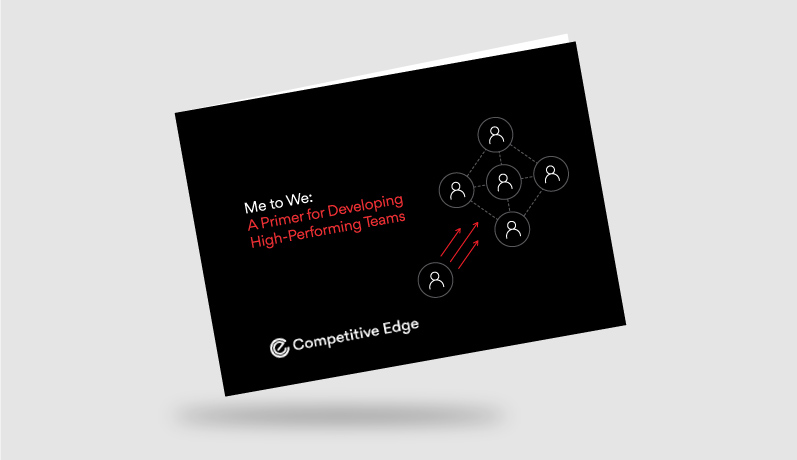As pressure on their time increases, leaders often lack the bandwidth to properly prepare for essential one-to-one meetings with their direct reports and team members.
Imagine this scenario: You’re just 15 minutes away from a crucial meeting with a team member. You’ve been running between back-to-back meetings, and the fog from endless conversations is clouding your ability to prepare for a much-needed, fruitful discussion. Remember, this meeting may be their only one with you, and they’ll rightfully expect your complete focus and attention. How can you ensure you make the most of your time together?
Think the ‘EDGE’, a simple yet effective framework for making one-to-one meetings more productive.
In the EDGE framework:
E is for Empathy
Be empathetic, listen actively and try to understand the other person’s perspective before seeking to be understood. Focus on the positive and ask follow-up questions that will help you engage. Remember, these meetings shouldn’t resemble interviews or interrogations but should foster genuine conversation. Adopt a ‘we-centric’ mindset to encourage connection and collaboration. Focus on building a positive relationship from the beginning of the meeting, and don’t dictate your agenda to the other person.
Your team member may feel apprehensive about this discussion if they are struggling, so before you start asking challenging questions that could send them into a tailspin, ask them about their successes and what they did to make them happen. People are more likely to open up about their difficulties and be more proactive in finding solutions if they don’t feel targeted so early in the conversation. Although this feels counter-intuitive because you want to get to the point quickly, rushing into a performance conversation means they are more likely to put the brakes on.
Ask questions like:
- What has gone well since we last spoke?
- What did you do to make this work so well?
Then you can move into questions to identify the areas that aren’t working well, like:
- What has not gone so well?
- If you were starting again, what would you do differently?
Depending on the answers you receive, ask follow-up questions to gain a better understanding.
D is for Discernment
Be wise in these interactions. Understand that while knowledge speaks, wisdom listens. Don’t just listen to what’s explicitly communicated; try to pay attention to non-verbal cues. These queues will tell you more about the authenticity of their answers if you have put them at ease with some genuine empathy. When asking questions, consider the bigger picture, not just the immediate matters.
Be attentive, recognise conflicting priorities and guide individuals through them rather than telling them what to do. Growth is about self-learning. If you rush in and tell them what to do, you reinforce their dependency on you, meaning they need more of your time.
Discernment helps you understand if your team member is avoiding things (either deliberately or not) or experiencing genuine barriers to success. Are they shirking, or are they struggling? View what they say in the context of what is happening and look for cues related to accountability and responsibility.
Ask questions like:
- What’s on your mind?
- What are your biggest challenges?
- What’s standing in your way?
- On a scale of 1 to 10, how much of a challenge is that right now?
Depending on the answers you receive, ask follow-up questions to learn more.
G is for Goals
One of the biggest challenges line managers face is their people’s productivity. Team members are often busy but can be busy doing the wrong things, not always prioritising productive tasks. Spend time focusing on past, present, and future goals. It is not just about ticking off KPIs but reflecting on past achievements, understanding current progress, and identifying potential adjustments for the future.
Setting goals and objectives is essential when agreeing on a person’s direction of travel. It aligns their day-to-day activity with the broader aims of the business.
Goals bring clarity to the team members; if set together rather than given, you build a stronger sense of commitment. Goals on their own bring direction, while goals explored and set together bring motivation.
Genuine buy-in will also foster personal growth. It is natural for people who buy in to want to achieve and improve, which is what you want as a leader. The other great benefit of setting and achieving goals is that you have a way for them to self-assess, meaning those who buy in will move toward self-management.
Ask questions like:
- How far along do you think you are?
- What will you achieve in the next week, month or year?
- What does success look like for you?
Depending on the answers you receive, ask follow-up questions to align your thinking further.
E is for Empowerment
Assess whether individuals have the capability, tools, and support they need to accomplish their tasks. Are they too dependent on their manager, and if so, how can you build a pathway towards autonomy?
Empowerment is where motivation is accelerated. Establishing clarity, unity, and integrity helps team members feel valued, equipped and ready to act.
Confidence is one of the most significant performance contributors. A lack of self-belief can stop a person in their tracks. It is essential to continue to build the person up, so even during challenging conversations, using empathy and discernment, you need to continue to think about your team member’s mindset and show them how they can achieve it, not give them a hard time for why they haven’t.
If your employee leaves the meeting feeling demoralised, don’t expect them to deliver sustained performance improvement. While tough talk has immediate effects, it rarely yields sustained results.
Ask questions like:
- What do you want?
- What do you need?
- How can I help?
Depending on the answers you receive, ask follow-up questions to increase a sense of ownership further.
EDGE is not a step-by-step approach but a list of ingredients that, when combined, help achieve the desired outcome you both need. So, before going into your next one-to-one meeting, think EDGE — empathy, discernment, goals, and empowerment.


